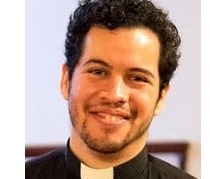Christ Jesus is the image of the invisible God, the firstborn of all creation; for in him all things in heaven and on earth were created, things visible and invisible, whether thrones or dominions or rulers or powers– all things have been created through him and for him. He himself is before all things, and in him all things hold together. He is the head of the body, the church; he is the beginning, the firstborn from the dead, so that he might come to have first place in everything. For in him all the fullness of God was pleased to dwell, and through him God was pleased to reconcile to himself all things, whether on earth or in heaven, by making peace through the blood of his cross…
I am now rejoicing in my sufferings for your sake, and in my flesh I am completing what is lacking in Christ’s afflictions for the sake of his body, that is, the church. I became its servant according to God’s commission that was given to me for you, to make the word of God fully known, the mystery that has been hidden throughout the ages and generations but has now been revealed to his saints. To them God chose to make known how great among the Gentiles are the riches of the glory of this mystery, which is Christ in you, the hope of glory.
Colossians 1:15-20, 24-27
Back in my seminary days, someone drew my attention to an unusual icon. Jesus stands at the edge of a stream, draped in his usual flowing robes, and before him are a whole host of creatures: fish and birds of all kinds, their colorful plumage and scales filling every corner of the frame.
We are to assume that Jesus is in the process of giving every creature their name. He stands in his middle-eastern garb in the time before time; the “firstborn of all creation” giving life and breath to everything that was, and is, and is to come.
The Colossians passage above—one of today’s daily office readings—is a rich theological reflection on the identity of Jesus of Nazareth. This presents a bit of a gloss on the creation stories written thousands of years prior, though it is not entirely without precedent. The New Testament writer was likely aware of the tendency in Jewish literature to personify Wisdom as the “image of God’s goodness” (Wisdom 7:26).
In any case, the passage above provides a sophisticated understanding of the Crucified Messiah’s identity. In Jesus, the divine and human natures come together in perfect harmony. Jesus—in his very being, not simply by his death on the cross—bridges the widest gap of all, that between human frailty and God’s eternity. In Jesus, the divine is present with us in flesh and bone.
In reference to the Eucharist, St. Augustine is famous for saying: “Be what you see, and receive what you are” (Sermon 272). In Jesus’ body, we have a gateway to the divine, which is to say that, when we take the Eucharist, the divine lives within us. What does it look like to take this message seriously? What would it mean for you to see yourself and others as vessels of the divine mystery?
It may mean that we take greater care of the person we see looking back at us in the mirror. It may mean that we appreciate the gift that is our neighbor, whomever they might be. Jesus has reconciled earth and heaven, brought them together in his body. The heavy-lifting has been done for us—so let us go and do likewise.
—Fr. Javier


